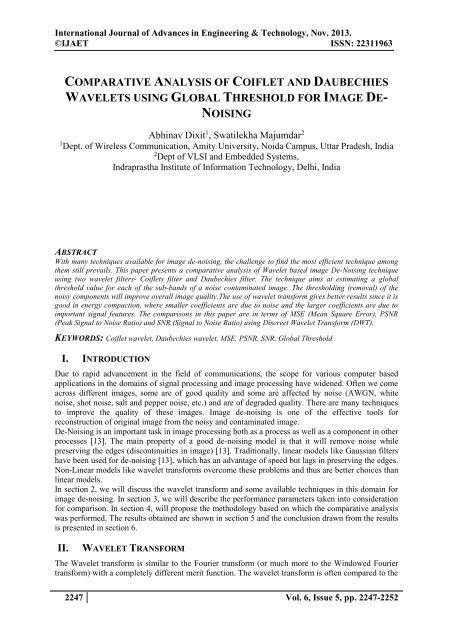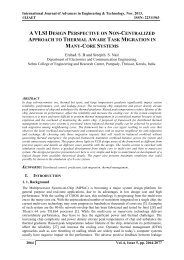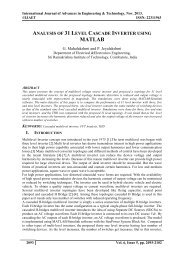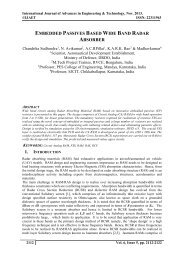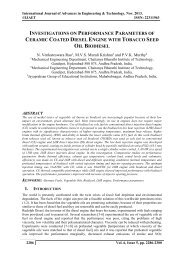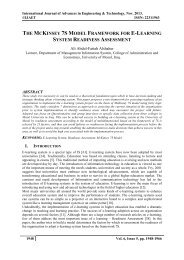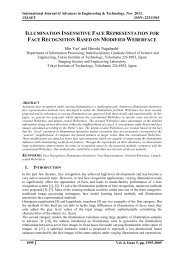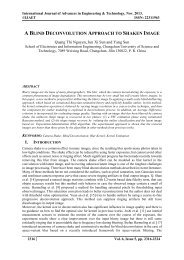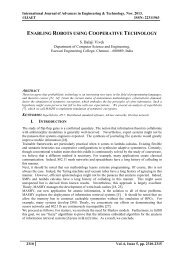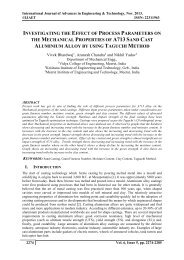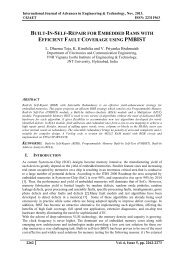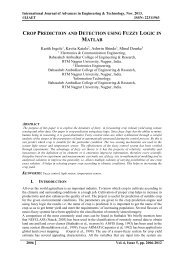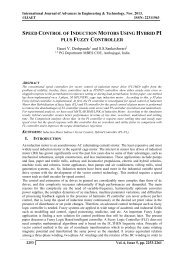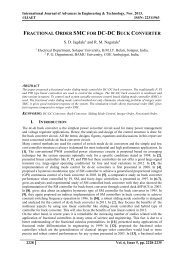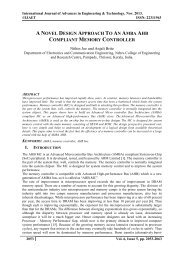COMPARATIVE ANALYSIS OF COIFLET AND DAUBECHIES WAVELETS USING GLOBAL THRESHOLD FOR IMAGE DE-NOISING
With many techniques available for image de-noising, the challenge to find the most efficient technique among them still prevails. This paper presents a comparative analysis of Wavelet based image De-Noising technique using two wavelet filters- Coiflets filter and Daubechies filter. The technique aims at estimating a global threshold value for each of the sub-bands of a noise contaminated image. The thresholding (removal) of the noisy components will improve overall image quality.The use of wavelet transform gives better results since it is good in energy compaction, where smaller coefficients are due to noise and the larger coefficients are due to important signal features. The comparisons in this paper are in terms of MSE (Mean Square Error), PSNR (Peak Signal to Noise Ratio) and SNR (Signal to Noise Ratio) using Discreet Wavelet Transform (DWT).
With many techniques available for image de-noising, the challenge to find the most efficient technique among them still prevails. This paper presents a comparative analysis of Wavelet based image De-Noising technique using two wavelet filters- Coiflets filter and Daubechies filter. The technique aims at estimating a global threshold value for each of the sub-bands of a noise contaminated image. The thresholding (removal) of the noisy components will improve overall image quality.The use of wavelet transform gives better results since it is good in energy compaction, where smaller coefficients are due to noise and the larger coefficients are due to important signal features. The comparisons in this paper are in terms of MSE (Mean Square Error), PSNR (Peak Signal to Noise Ratio) and SNR (Signal to Noise Ratio) using Discreet Wavelet Transform (DWT).
You also want an ePaper? Increase the reach of your titles
YUMPU automatically turns print PDFs into web optimized ePapers that Google loves.
International Journal of Advances in Engineering & Technology, Nov. 2013.<br />
©IJAET ISSN: 22311963<br />
<strong>COMPARATIVE</strong> <strong>ANALYSIS</strong> <strong>OF</strong> <strong>COIFLET</strong> <strong>AND</strong> <strong>DAUBECHIES</strong><br />
<strong>WAVELETS</strong> <strong>USING</strong> <strong>GLOBAL</strong> <strong>THRESHOLD</strong> <strong>FOR</strong> <strong>IMAGE</strong> <strong>DE</strong>-<br />
<strong>NOISING</strong><br />
Abhinav Dixit 1 , Swatilekha Majumdar 2<br />
1 Dept. of Wireless Communication, Amity University, Noida Campus, Uttar Pradesh, India<br />
2 Dept of VLSI and Embedded Systems,<br />
Indraprastha Institute of Information Technology, Delhi, India<br />
ABSTRACT<br />
With many techniques available for image de-noising, the challenge to find the most efficient technique among<br />
them still prevails. This paper presents a comparative analysis of Wavelet based image De-Noising technique<br />
using two wavelet filters- Coiflets filter and Daubechies filter. The technique aims at estimating a global<br />
threshold value for each of the sub-bands of a noise contaminated image. The thresholding (removal) of the<br />
noisy components will improve overall image quality.The use of wavelet transform gives better results since it is<br />
good in energy compaction, where smaller coefficients are due to noise and the larger coefficients are due to<br />
important signal features. The comparisons in this paper are in terms of MSE (Mean Square Error), PSNR<br />
(Peak Signal to Noise Ratio) and SNR (Signal to Noise Ratio) using Discreet Wavelet Transform (DWT).<br />
KEYWORDS: Coiflet wavelet, Daubechies wavelet, MSE, PSNR, SNR, Global Threshold<br />
I. INTRODUCTION<br />
Due to rapid advancement in the field of communications, the scope for various computer based<br />
applications in the domains of signal processing and image processing have widened. Often we come<br />
across different images, some are of good quality and some are affected by noise (AWGN, white<br />
noise, shot noise, salt and pepper noise, etc.) and are of degraded quality. There are many techniques<br />
to improve the quality of these images. Image de-noising is one of the effective tools for<br />
reconstruction of original image from the noisy and contaminated image.<br />
De-Noising is an important task in image processing both as a process as well as a component in other<br />
processes [13]. The main property of a good de-noising model is that it will remove noise while<br />
preserving the edges (discontinuities in image) [13]. Traditionally, linear models like Gaussian filters<br />
have been used for de-noising [13], which has an advantage of speed but lags in preserving the edges.<br />
Non-Linear models like wavelet transforms overcome these problems and thus are better choices than<br />
linear models.<br />
In section 2, we will discuss the wavelet transform and some available techniques in this domain for<br />
image de-noising. In section 3, we will describe the performance parameters taken into consideration<br />
for comparison. In section 4, will propose the methodology based on which the comparative analysis<br />
was performed. The results obtained are shown in section 5 and the conclusion drawn from the results<br />
is presented in section 6.<br />
II.<br />
WAVELET TRANS<strong>FOR</strong>M<br />
The Wavelet transform is similar to the Fourier transform (or much more to the Windowed Fourier<br />
transform) with a completely different merit function. The wavelet transform is often compared to the<br />
2247 Vol. 6, Issue 5, pp. 2247-2252
International Journal of Advances in Engineering & Technology, Nov. 2013.<br />
©IJAET ISSN: 22311963<br />
Fourier transform in which signals are represented as a sum of sinusoids. Less distortion to the<br />
spectral characteristics of the de-noised image distinguishes wavelet transform from other techniques.<br />
The main difference between Wavelet transform and Fourier transform is that, in the Wavelet<br />
Transform, wavelets are localized in both time and frequency whereas in the standard Fourier<br />
transform, wavelets are only localized infrequency. The Short-time Fourier transform (STFT) is more<br />
similar to the wavelet transform. In this also the wavelets are time and frequency localized but there<br />
are issues with the frequency/time resolution trade-off. Wavelets often give a better signal<br />
representation using Multi-resolution analysis with balanced resolution at any time and frequency.<br />
While Fourier analysis consists of breaking up the signal into sine waves of various frequencies,<br />
Wavelet analysis consists of breaking up the signal into shifted and scaled versions of the original (or<br />
mother) wavelet. Just by analyzing the wavelets and sine waves, we can conclude intuitively that<br />
signals with sharp changes might be better analyzed with an irregular wavelet than with a smooth<br />
sinusoid, just as some foods are better handled with a fork than a spoon [12].<br />
2.1 Discrete Wavelet Transform<br />
DWT transforms discrete signal from time domain to frequency domain i.e., it provides time and<br />
frequency representation of the signal. The signal to be decomposed is analyzed at different frequency<br />
bands with different resolution. The decomposition takes place by transmitting the signal to series of<br />
HPF and LPF.<br />
2.2 Coieflet Wavelets<br />
Figure 1 DWT Decomposition Tree<br />
The wavelet function has 2N moments equal to 0 and the scaling function has 2N-1 moments equal to<br />
0. The two functions have a support of length 6N-1. General characteristics: Compactly supported<br />
wavelets with highest number of vanishing moments for both phi and psi for a given support width.<br />
[12]<br />
2.3 Haar Wavelet<br />
Figure 2Coieflet Wavelet Families<br />
This was the first and most widely used wavelet. A Haar Wavelet is a certain sequence of rescaled<br />
“square-shaped” function which together forms a wavelet family or basis. Its technical disadvantage is<br />
that it is not continuous, therefore not differentiable. This property can be an advantage when<br />
monitoring of tool failure in machine is analyzed.<br />
The Haar wavelet's mother wavelet function can be described as<br />
2248 Vol. 6, Issue 5, pp. 2247-2252
International Journal of Advances in Engineering & Technology, Nov. 2013.<br />
©IJAET ISSN: 22311963<br />
Its scaling function can be described as<br />
(1)<br />
(2)<br />
2.4 Daubechies Wavelet<br />
Figure 3Haar Wavelet Transform<br />
These are family of orthogonal wavelets defining a DWT and are characterized by a maximal number<br />
of vanishing moments for some given support. With each wavelet type of this class, there is a scaling<br />
function (called father wavelet) which generates an orthogonal multi-resolution analysis.<br />
Figure 4Daubechies Wavelet Families<br />
III.<br />
PER<strong>FOR</strong>MANCE PARAMETERS<br />
The amount of noise removed and the quality of reconstruction of the image is evaluated in terms of<br />
following parameters:<br />
3.1 Mean Square Error (MSE)<br />
MSE measures average of the square of the errors i.e., the cumulative squared error between the<br />
compressed and original image.<br />
MSE =<br />
1<br />
m n<br />
m−1 n−1<br />
∑ ∑[I(i, j) − K(i, j)]2<br />
i=0<br />
j=0<br />
Where I(i,j) is the original image, K(i,j) is the de-noised image and m, n are the image dimensions. A<br />
lower value of MSE shows less error.<br />
3.2 Peak Signal to Noise Ratio (PSNR)<br />
PSNR measures quality of the reconstructed signal. It is defined as a ratio between maximum possible<br />
value of a signal (power) and the power of the noise by which the image get affected.<br />
(3)<br />
2249 Vol. 6, Issue 5, pp. 2247-2252
International Journal of Advances in Engineering & Technology, Nov. 2013.<br />
©IJAET ISSN: 22311963<br />
(4)<br />
Here, MAX I is the maximum possible pixel value of the image and MSE is Mean Square Error. A<br />
Higher value of PSNR shows high quality reconstruction.<br />
3.3 Signal To Noise Ratio<br />
SNR is defined as Signal Power to Noise Power. A higher value of SNR is always preferred since it<br />
signifies larger amount of signal content than the noise content in the signal, resulting in proper<br />
reconstruction.<br />
SNR = 20 ∗ log 10 ( A signal<br />
A noise<br />
)<br />
SNR = 10 ∗ log 10 ( A signal<br />
) (5)<br />
A noise<br />
IV. METHODOLOGY<br />
To compare the filters for de-noising purpose the tool MATLAB was used. The images under study<br />
are standard image used in MATLAB.<br />
Step 1: Three Noisy images (Lena, Barbara and Thinker) are considered.<br />
Step 2: Concept of Multiple-level wavelet decomposition is used on the input images, in which the<br />
image is decomposed and broken down in to multiple lower resolution components. (Figure 5)<br />
2<br />
Figure 5 Multi-Level Decomposition<br />
Step 3: The two wavelet filters, namely Coieflet and Daubechies, are applied to each of the images to<br />
perform de-noising operation.<br />
Step 4: A Global Threshold is estimated to remove noisy coefficients from the image.<br />
Step 5: De-noising image is reconstructed back.<br />
Step 6: The level and quality of reconstruction is evaluated in terms of following parameters<br />
Mean Square Error (MSE).<br />
Peak Signal to Noise Ratio (PSNR).<br />
Signal to Noise Ratio.<br />
V. RESULT<br />
In this paper, the results are obtained at 3 rd level of decomposition. The proposed methodology was<br />
based on the results obtained from the tool MATLAB. The table below shows that Coiflet filter has<br />
higher value of MSE, PSNR and SNR for all the three images as compared to Daubechies filter.<br />
2250 Vol. 6, Issue 5, pp. 2247-2252
International Journal of Advances in Engineering & Technology, Nov. 2013.<br />
©IJAET ISSN: 22311963<br />
Table 1 Result comparison between Wavelet Filters<br />
Image Daubechies Wavelets Coiflet Wavelet<br />
MSE PSNR SNR MSE PSNR SNR<br />
LENA 19.8668 80.9348 26.7019 17.3779 82.2733 27.3232<br />
BARBARA 301.7555 53.7291 17.1073 266.9607 54.9543 17.6704<br />
THINKER 16.4012 82.8517 28.5223 15.7343 83.2668 28.8209<br />
LENA:<br />
Table 2 Original and De-Noised Lena image<br />
De-Noised<br />
Original: Coiflet Wavelet Daubechies Wavelets<br />
Table 3 Original and De-Noised Barbara Image<br />
BARBARA:<br />
De-Noised<br />
Original: Coiflet Wavelet Daubechies Wavelets<br />
Table 4 Original and De-Noised Thinker Image<br />
THINKER:<br />
De-Noised<br />
Original: Coiflet Wavelet Daubechies Wavelets<br />
2251 Vol. 6, Issue 5, pp. 2247-2252
International Journal of Advances in Engineering & Technology, Nov. 2013.<br />
©IJAET ISSN: 22311963<br />
VI.<br />
CONCLUSION<br />
The evaluation of the quality of de-noising is described in terms of MSE, PSNR, and SNR. From the<br />
results we concluded that use of Coiflet Wavelet Filter shows a higher value of MSE, SNR and PSNR<br />
compared to Daubechies Wavelets Filter signifying better image reconstruction of image from its<br />
noisy counterpart. Also a high value of PSNR shows a good amount of de-noisingand a high value of<br />
SNR shows less amount of noise. Hence, we can conclude that Coiflet Wavelet filter is better than<br />
other techniques considered for image de-noising.<br />
REFERENCES<br />
[1] Andrea Gavlasov´a, AleˇsProch´azka, and Martina Mudrov´, WAVELET BASED <strong>IMAGE</strong><br />
SEGMENTATION, 2010.<br />
[2] Ashok,T.Balakumaran, C.Gowrishankar, Dr.ILA.Vennila, Dr.A.Nirmalkumar, The Fast Haar Wavelet<br />
Transform for Signal & Image Processing, (IJCSIS) International Journal of Computer Science and Information<br />
Security, Vol. 7, No. 1, 2010.<br />
[3] Andreas Savakis and Richard Carbone, Discrete Wavelet Transform Core for Image Processing<br />
Applications, SPIE-IS&T/ Vol. 5671, 2012.<br />
[4] Lakhwinder Kaur, Savita Gupta, R.C. Chauhan, Image De-noising using Wavelet Thresholding, 2007.<br />
[5] JIANG Tao, ZHAO Xin, Research and Application of Image De-Noising Method Based On Curvelet<br />
Transform, Commission II, WG II/2, Vol. XXXVII. Part B2. Beijing 2008.<br />
[6] Sachin D Ruikar, Dharmpal D Doye, Wavelet Based Image De-noising Technique, International Journal of<br />
Advanced Computer Science and Applications, Vol. 2, No.3, March 2011.<br />
[7] Rohtash Dhiman, Sandeep Kumar, An Improved Threshold Estimation Technique For Image De-Noising<br />
Using Wavelet Thresholding Techniques, Volume 1, Issue 2 (October, 2011).<br />
[8] Akhilesh Bijalwan, Aditya Goyal, NidhiSethi, Wavelet Transform Based Image Denoise Using Threshold<br />
Approaches, International Journal of Engineering and Advanced Technology, Volume-1, Issue-5, June 2012.<br />
[9] D.Srinivasulu Reddy, Dr.S. Varadarajan ,Dr.M.N. GiriPrasad, 2D-DTDWT Based Image De-noising using<br />
Hard and Soft Thresholding, IJERA, Vol. 3, Issue 1, January -February 2013.<br />
[10] Sachin D Ruikar, Dharmpal D Doye, Wavelet Based Image De-noising Technique, IJACSA, March 2011.<br />
[11] Marcin Kociołek1, Andrzej Materka1, Michał Strzelecki1, Piotr Szczypiński1, DWT, Proc. of International<br />
Conference on Signals and Electronic Systems,18-21 September 2001, Lodz, Poland, pp. 163-168.<br />
[12] Sandeepkaur, GaganpreetKaur, Dr.Dheerendra Singh, Comparative Analysis Of Haar And Coiflet Wavelets<br />
Using Discrete Wavelet Transform In Digital Image Compression, International Journal of Engineering<br />
Research and Applications (IJERA) ISSN: 2248-9622, Vol. 3, Issue 3, May-Jun 2013, pp.669-673.<br />
[13] Suresh.R (ME), Kannadhasan.G(ME),Jebin.P.L(ME), Image Denoising using new digital pulsemode neural<br />
network, International Journal of Engineering Trends and Technology-Volume4Issue2-2013.<br />
[14] Jappreet Kaur, Manpreet Kaur, Poonamdeep Kaur, Manpreet Kaur, Comparative Analysis Of Image Denoising<br />
Techniques, ISSN 2250-2459,Volume 2, Issue 6, June2012.<br />
AUTHORS PR<strong>OF</strong>ILE<br />
Abhinav Dixit is pursing Masters in Wireless Communications from Amity University,<br />
Noida, Uttar Pradesh. He did his bachelors from UPTU, India.<br />
Swatilekha Majumdar is pursing Masters in VLSI Technology from Indraprastha Institute<br />
of Information Technology, Delhi and currently working as an intern in ST<br />
Microelectronics, India. She did her bachelors from Guru Gobind Singh Indraprastha<br />
University, Delhi and has been a member of IEEE and IEEE WIE since 2012.<br />
2252 Vol. 6, Issue 5, pp. 2247-2252


